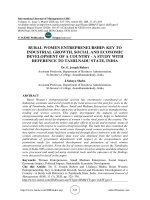Economic growth and economic development 579
Bạn đang xem bản rút gọn của tài liệu. Xem và tải ngay bản đầy đủ của tài liệu tại đây (63.22 KB, 1 trang )
Introduction to Modern Economic Growth
entrants’ incentives to improve over this product and replace the monopolist as the
main supplier of the product. Despite the appropriability and the replacement effects, the amount of innovation in equilibrium can be excessive, because of another,
countervailing force, the business stealing effect, which encourages firms to undertake innovations in order to become the new monopolist and take over (“steal”) the
monopoly rents. Therefore, whether there is too little or too much innovation in
equilibrium depends on the market structure and the parameters of the model.
This chapter has also introduced the Dixit-Stiglitz-Spence (or for short the DixitStiglitz) model, which will play an important role in the analysis of the next few
chapters. This model enables a very tractable approach to Chamberlin type of
monopolistic competition, where each firm has some monopoly power, but free entry
ensures that all firms (or the marginal entrants) make zero profits. The DixitStiglitz model is particularly tractable because the markup charged by monopolists
is independent of the number of competing firms. This makes it an ideal model
to study endogenous growth, because it will enable innovation to remain profitable
even when the number of products or the number of machines increase continuously.
12.7. References and Literature
The literature on R&D in industrial organization is vast, and our purpose in this
chapter has not been to review this literature, but to highlight the salient features
that will be used in the remainder of the book. The reader who is interested in
this area can start with Tirole (1990, Chapter 10), which contains an excellent
discussion of the contrast between private and the social values of innovation. It
also provides a simple introduction to patent races, which will feature later in the
book. A more up-to-date reference that surveys the recent developments in the
economics of innovation is Scotchmer (2005).
The classic reference on the private and social values of innovation is Arrow
(1962). Schumpeter (1943) was the first to emphasize the role of monopoly in
R&D and innovation. The importance of monopoly power for innovation and the
indications of the non-rival nature of ideas are discussed in Romer (1990, 1993) and
Jones (2006). Most of the industrial organization literature also emphasizes the
importance of ex post monopoly power and patent systems in providing incentives
565









